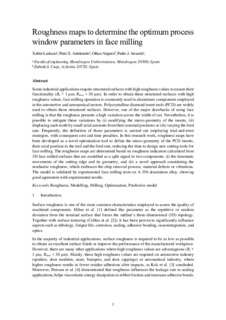| dc.contributor.author | Lazkano Rayo, Xabier | |
| dc.contributor.author | Aristimuño, Patxi Xabier | |
| dc.contributor.author | ARRAZOLA, PEDRO JOSE | |
| dc.contributor.other | Aizpuru, Oihan | |
| dc.date.accessioned | 2022-04-07T08:58:17Z | |
| dc.date.available | 2022-04-07T08:58:17Z | |
| dc.date.issued | 2022 | |
| dc.identifier.issn | 0020-7403 | en |
| dc.identifier.other | https://katalogoa.mondragon.edu/janium-bin/janium_login_opac.pl?find&ficha_no=167516 | en |
| dc.identifier.uri | https://hdl.handle.net/20.500.11984/5524 | |
| dc.description.abstract | Some industrial applications require structured surfaces with high roughness values to ensure their functionality (Ra > 1 µm, Rmax < 30 µm). In order to obtain these structured surfaces with high roughness values, face milling operation is commonly used in aluminium components employed in the automotive and aeronautical sectors. Polycrystalline diamond insert tools (PCD) are widely used to obtain those structured surfaces. However, one of the major drawbacks of using face milling is that the roughness presents a high variation across the width of cut. Nevertheless, it is possible to mitigate these variations by (i) modifying the micro-geometry of the inserts, (ii) displacing each tooth by small axial amounts from their nominal positions or (iii) varying the feed rate. Frequently, the definition of those parameters is carried out employing trial-and-error strategies, with consequent cost and time penalties. In this research work, roughness maps have been developed as a novel optimisation tool to define the micro-geometry of the PCD inserts, their axial position in the tool and the feed rate, reducing the time to design new cutting tools for face milling. The roughness maps are determined based on roughness indicators calculated from 3D face milled surfaces that are modelled as a split signal in two components: (i) the kinematic movements of the cutting edge and its geometry, and (ii) a novel approach considering the stochastic roughness, which embraces the chip removal process, material defects or vibrations. The model is validated by experimental face milling tests on A-356 aluminium alloy, showing good agreement with experimental results. | en |
| dc.description.sponsorship | Gobierno Vasco | es |
| dc.language.iso | eng | en |
| dc.publisher | Elsevier Ltd. | en |
| dc.rights | © 2022 Elsevier Ltd. | en |
| dc.subject | Roughness | en |
| dc.subject | Modelling | en |
| dc.subject | milling | en |
| dc.subject | Optimisation | en |
| dc.subject | Predictive model | en |
| dc.title | Roughness maps to determine the optimum process window parameters in face milling | en |
| dc.type | http://purl.org/coar/resource_type/c_6501 | |
| dcterms.accessRights | http://purl.org/coar/access_right/c_f1cf | en |
| dcterms.source | International Journal of Mechanical Sciences | en |
| local.contributor.group | Mecanizado de alto rendimiento | es |
| local.description.peerreviewed | true | en |
| local.identifier.doi | https://doi.org/10.1016/j.ijmecsci.2022.107191 | en |
| local.relation.projectID | info:eu-repo/grantAgreement/GV/Programa de apoyo a la I+D Empresarial Hazitek 2020/ZL-2020-00305/CAPV/Diseño y fabricación de herramientas de diamante policristalino (PCD) optimizadas/OptiPCD | en |
| local.relation.projectID | info:eu-repo/grantAgreement/GV/Elkartek 2019/KK-2019-00077/CAPV/Superficies multifuncionales en la frontera del conocimiento/FRONTIERS V | en |
| local.embargo.enddate | 2024-05-31 | |
| local.contributor.otherinstitution | https://ror.org/03jyntf28 | es |
| local.source.details | Vol. 221. N. artículo 107191, 2021 | en |
| oaire.format.mimetype | application/pdf | |
| oaire.file | $DSPACE\assetstore | |
| oaire.resourceType | http://purl.org/coar/resource_type/c_6501 | en |
| oaire.version | http://purl.org/coar/version/c_ab4af688f83e57aa | en |







